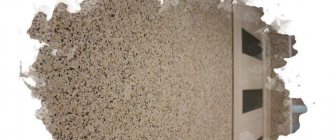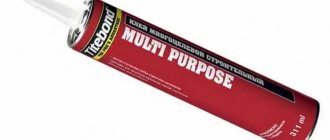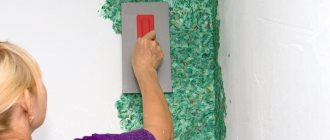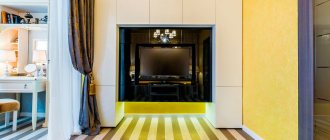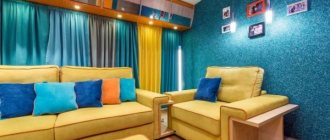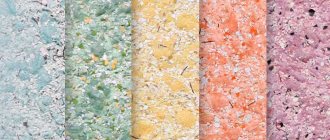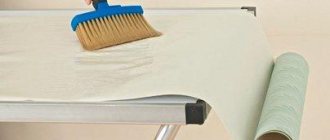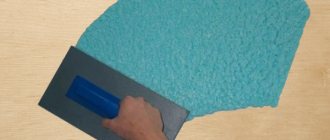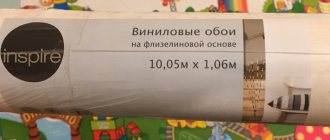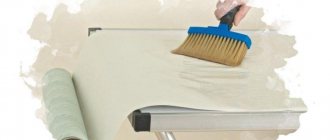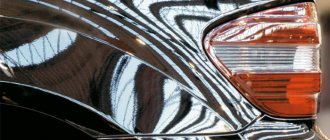Updated: 03/06/2021 14:56:10
Expert: Andrey Nikolaevich Kuznetsov
*Review of the best according to the editors of expertology.ru. About the selection criteria. This material is subjective in nature, does not constitute advertising and does not serve as a purchase guide. Before purchasing, consultation with a specialist is required.
When renovating an apartment, house or interior decoration of a new building, you can use liquid wallpaper. This is a type of decorative plaster, but instead of sand it uses natural fibers (cotton, silk, cellulose or mixtures thereof). The substance is applied with a grater, and after drying it forms a soft textile surface with sound and heat insulation effects. The finish hides cracks well and smoothes out surface defects.
But when choosing, buyers have a question about which manufacturer of liquid wallpaper is better, because the quality and service life depend on this. We conducted a study and compiled a rating of the best foreign and domestic companies producing liquid wallpaper. The construction of the TOP 10 was based on the technologies used in production and the characteristics of the goods, as well as the assessment of users and craftsmen in reviews.
Rating of liquid wallpaper manufacturers
You can renovate your apartment using domestic decorative compositions or collections from well-known global companies. Materials have different characteristics, prices, and aesthetics. To compile the review, our experts selected products from well-known Russian and European brands. The quality of finishing, consumption, and ultraviolet resistance were checked. Reviews of liquid wallpaper from users, opinions of professional builders and designers were taken into account.
The main attention was paid to the following characteristics:
- Fiber composition – wallpaper is produced with cotton, silk, cellulose, and combined threads;
- Texture – surface relief affects tactile sensations;
- Adhesive base – drying speed and adhesion to the wall depend on the composition;
- Binders - used as a hardener for the fiber mass, impart elasticity to the coating, and are vapor permeable;
- Pigments – give the main color, affect resistance to ultraviolet radiation;
- Additives - antifungal compounds improve biostability, decorative elements add additional color;
- Degree of readiness – ready-to-use formulations and mixtures that require preliminary dilution are produced.
Not all types of products satisfied the experts' requests. Weak adhesion, extended drying time, crumbling, uneven shade - manufacturers of finishing materials with such defects were excluded from our rating.
Tips for choosing
It’s worth choosing liquid wallpaper based on some basic criteria:
- Calculation. The consumption of liquid wallpaper is calculated individually. 1 kg of mixture covers approximately 5 sq.m.
- Compound. It must be environmentally friendly and safe. Otherwise, residents will develop allergies that are dangerous to life and health.
- Texture. The range of wallpapers is wide - from smooth to embossed. The choice depends on the user's intentions.
How to choose liquid wallpaper
Anyone who has ever held a spatula in their hand can buy inexpensive liquid wallpaper and make original repairs. The compositions are easily applied to the prepared surface, and in skillful hands they are a material from which you can create unique paintings and complex ornaments. To enjoy the result for 10-15 years, you need to choose the right wallpaper. It is recommended to pay attention to the fiber composition, texture, color saturation. Properly selected material will delight you with tactile sensations, durability, and easy maintenance.
Fiber composition
Blends based on silk, cellulose, cotton, and silk-cellulose fiber are produced. Silk does not fade in the sun, is elastic, and has a pleasant tactile sensation. Wallpapers based on artificial and natural fibers have a long service life. The disadvantage of coverage is the high price.
Cellulose-based mixtures belong to the budget category. They form a coating with good vapor permeability, which has a weak texture and short service life. Collections based on cotton fiber, textured. The service life is longer than that of cellulose-based coatings. Combined compositions have all the advantages of the materials used. Manufacturers add silk threads to cellulose for reinforcement and increase service life.
Texture
Fine-relief liquid wallpaper forms a smooth surface, lies on the base in a thin layer, and is characterized by low consumption. After mixing with water, the mixtures are highly plastic, which requires skills in work. Used in places with high load on the walls, they are well covered with protective acrylic varnishes. Adding flocks makes the texture more prominent.
Large-relief collections are recommended for walls with small defects. They hide chips and cracks well, are easy to apply by hand and are suitable for beginners. The addition of flocks does not have a strong effect on the texture, but favorably emphasizes the decorative qualities of large-relief wallpaper. You can make this type of composition yourself by adding finely chopped pieces of thick paper.
Chroma
Which liquid wallpaper is best for the bedroom, and which is more suitable for the living room? Manufacturers offer dozens, hundreds of shades. Preference is given to pastel colors, which create a cozy atmosphere in the bedroom, living room, kitchen, and hallway. Bright shades are recommended for game rooms, billiard rooms, hallways, and salons. Within one collection, colors are combined with each other, which allows you to create original combinations when implementing projects.
Preserving color is one of the main tasks of a property owner. Fading due to solar ultraviolet rays will lead to premature repairs. To prevent this from happening, it is recommended to use collections based on silk fibers that are resistant to UV radiation.
Pros and cons of the material
If you are still confused about whether to use this type of finishing or not, let’s weigh the pros and cons and understand the nuances.
Let us highlight the obvious advantages of F/O:
- Leveling “difficult” areas in apartments with many defects;
- Environmental friendliness (recommended for use in children's and medical institutions);
- Vapor permeability - able to “breathe”;
- Lifetime;
- Possibility of stylistic combination with different materials: ceramics, photo wallpaper, etc.;
- Cost-effective;
- There are no difficulties in restoring damaged areas;
- Avoids painful adjustments in corners, no seams;
- Antistatic effect;
Finishing of columns and arches due to plasticity, as well as the creation of panels and other decorative elements;
- Original, and most importantly - straight.
Unfortunately, we cannot do without a “fly in the ointment”. Let's take a closer look at the disadvantages:
- The price may seem high compared to traditional wallpaper;
- The color palette has pastel shades.
Additionally, special additives are used: mica, golden threads, marble chips, etc.;
- They are washed off with water, which is not practical in everyday life;
- Overspending is possible if you are doing such work for the first time.
Which manufacturer's liquid wallpaper is better?
Interesting design options, the ability to inexpensively make spectacular repairs, and versatility make this category of finishing materials relevant. What liquid wallpaper is best for decorating a house, apartment, or office? When answering this question, you need to take into account the budget, the specifics of the premises, and operating conditions. The VyborExperta.ru team recommends the following manufacturers:
- Silk Plaster – for those who are looking for original textures;
- Bioplast - for budget repairs;
- Silkcoat – for rooms where periodic wet cleaning of walls is required;
- Max-color - for author's repairs;
- Wema – for buildings subject to shrinkage.
The products of all manufacturers presented in the review comply with current SNiPs, but only those factories that offer collections with bright textures that guarantee a long service life are worthy of the title of the best manufacturers.
Comparison table of characteristics
The table below presents the main characteristics of the wallpaper brands in question. Compare them with each other and choose the most suitable option.
| Wallpaper name | Manufacturer | Brand Features | Assortment of shades |
| Max-color | Ukraine | variety of colors, natural eco-composition | 80 and more |
| Limil | Ukraine | used in damp areas | 120 options |
| POLDECO | Poland | wide range of textures and shades | 240 |
| Senideco | France | best quality from a French brand | over 30 |
| Silk Plaster | Russia | expanded range of textures and shades of wallpaper | 224 |
| Bayramix | Türkiye | quality, trust from users, many years of experience in creating coatings | more than 40 |
| Bioplast | Russia | one of the best wallpapers from a Russian manufacturer | near |
Surface preparation before coating
Preparation is one of the difficult stages in any decoration.
In this case it will consist of:
- surface leveling (rough leveling with plaster mixtures to prevent curvature)
- final leveling from defects, chips, cracks
- padding
- whitening with paint
The result is a clean white area without colored streaks or marks. We varnish the metal parts so that “everyone’s favorite” rusty spots and stains do not form on the new wall covering.
Preparation of the plane on different bases
In this description, we proceed from the condition that the first stage - rough alignment of the walls - has already occurred.
Plastered brick or concrete wall
Coating concrete or plaster with concrete is useless and ineffective work.
That's why:
- Pre-prime the plastered surface
- We carry out the final leveling - we cover up the defects using gypsum putty. Apply the solution in an even layer
- We cover it with a façade primer to prevent the gypsum mixture from absorbing moisture (all manufacturers recommend repeating the application in 2 layers). Can be treated with facade water-soluble paint with PVA in a ratio of 2:1.
- Paint with white acrylic paint, at least 2 layers to give it a white color.
- After applying each layer, wait for it to dry. Approximately the putty dries in 24-30 hours, the primer 24 hours.
Drywall
The process is the same as in the case of plaster bases, but do not forget to seal with putty or coat with oil paint all screws and other metal parts that may come into contact with our future wall covering.
Wooden surfaces: MDF, fiberboard, plywood
The main enemy for wooden products is water. When covering bare wood, fiberboard, plywood, etc., it may simply move or twist.
- We check that the work area is firmly secured.
- We cover the wood with primer with abrasive particles for external use to increase adhesion, in 2-3 layers.
- Next we use white water-soluble paint.
Other manufacturers
In addition to these leading manufacturers of liquid wallpaper, there are many others whose product quality is in no way better than that of the leading three. This:
Polish liquid wallpaper POLDECOR is a fairly recognizable company around the world, offering more than 200 product names. Regular packaging starting at RUB 1,000. planned for finishing an area of 3.3 sq. m.
Kasagawa (CASAVAGA) is a domestic manufacturer of the so-called. “Danish plaster” (it is sold with or without glue and looks like a tile for facing - look at the photo):
The cost of packaging is 300-700 rubles. and It depends on the type and size of the tile.
Liquid wallpaper SILKCOAT (Japan) - regular packaging for 4 sq. meters of coverage, the set includes a 100 ml bottle of color. Price from 1000 rub. The Silcoat product lines ELITE MILLENIUM, ELITE, PRESTIGE are especially familiar.
Read about how to soundproof metal doors and what materials are needed to “do it quietly” with your own hands.
Read about insulating the sound of an apartment with your own hands here - all the subtleties and secrets of soundproofing events are described in detail.
What qualities does impact-resistant window film have? Ask in a note: //okna/plenki/zashhitnaya-plenka.html
Liquid Goat wallpaper (BAYRAMIX KOZA) produced in Turkey is a much more economical type of eco-decor:
A package weighing 1 kilogram costs from 100 rubles. On average, the consumption of diluted material plus this will be 1.3-1.5 kilograms per square meter. About the advantages, not paying attention to the inexpensive cost of the Bayramix finishing material, see the video clip:
Preparation of the composition
Now let’s look at the preparation of this “miracle decoration product”.
When preparing for finishing work, we make a preliminary calculation of how much mixture we will need. Often, the manufacturer indicates in the instructions how much material is required to process 1 m². One package - 1 kg of special mixture - is enough to finish approximately 5 m² of surface.
We prepare the batch, guided by the following rules :
- It is advisable to use the whole package;
- It is better to knead by hand or with a mixer;
- always add the mixture to water;
- Apply the finish in a thin layer;
- It is recommended to store the prepared special mixture for a month in a closed container;
- To correctly calculate the volume per one working area, you should take into account information from the manufacturer, but it is better to take the material with a reserve; the batch consumption is 250 grams per m2.
A standard container has a volume of 1 kg, one package is consumed for an area of 3.5 - 5.5 square meters.
Stages of mixing the composition:
- to a measured amount of warm water until it becomes homogeneous.
- We wait 20-25 minutes and mix again.
- Let it sit for 6-12 hours until fully cooked.
- If it is necessary to make the raw material water-repellent, then add colorless acrylic varnish or a protective emulsion.
Important! Each package of L/O must be mixed separately.
